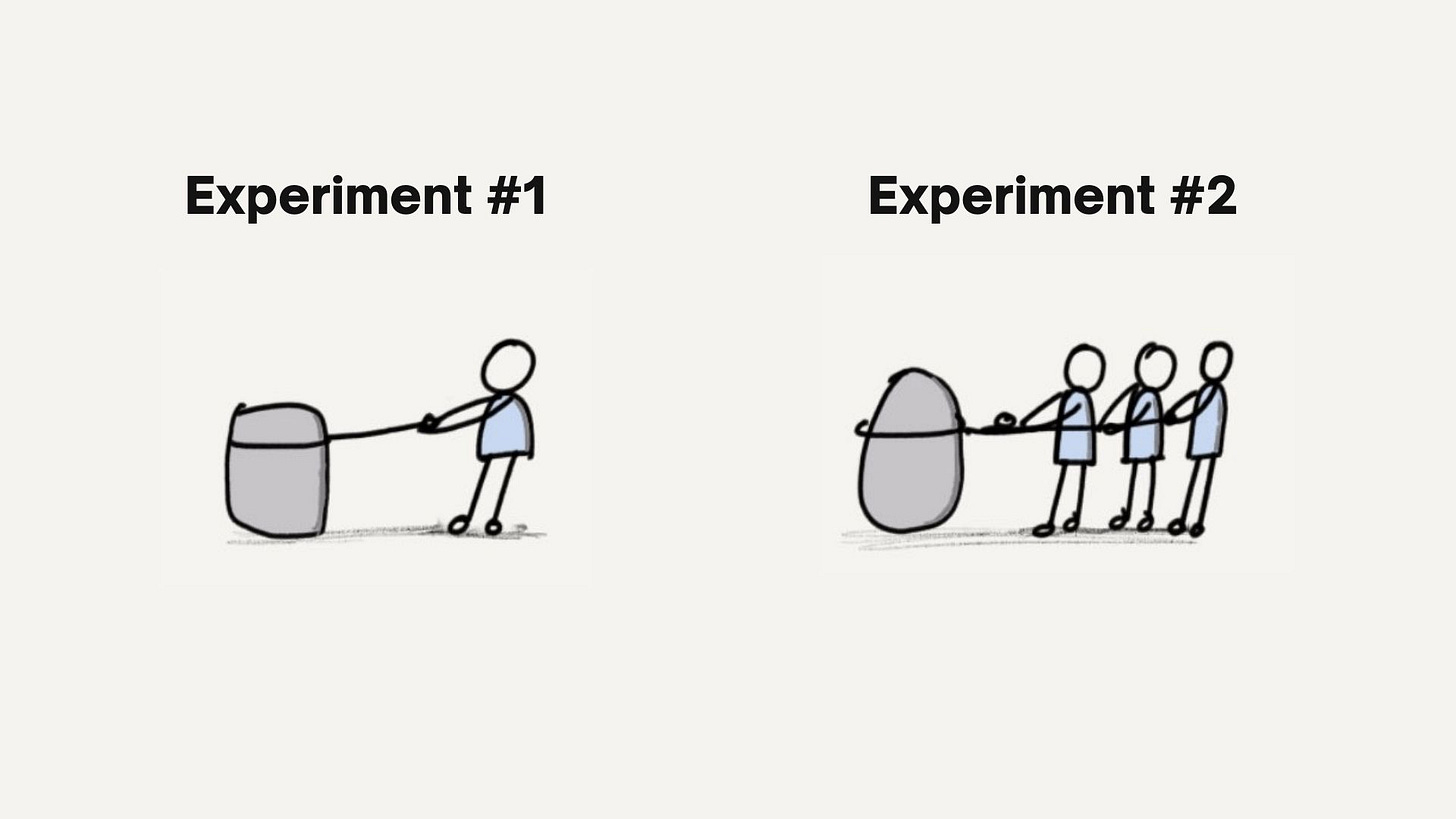Why Large Teams Suck? The Psychology Behind Amazon's 2 Pizza Rule.
Why adding more people doesn't increase team productivity?
👋 Hey Friends,
In the early days of Amazon, Jeff Bezos instituted a rule:
“Every internal team should be small enough that it can be fed with 2 pizzas.”
The goal wasn't to cut down on the catering bill. It was aimed at increasing the team’s efficiency and productivity.
The 2 Pizza Rule is a guideline for deciding “how many” attendees should be invited to a meeting or part of a team.
But why such a weird rule?
At least, that’s what I thought when I first got introduced to the rule.
After some research, I found that the “2 Pizzas” in the 2 Pizza Rule was a clever strategy.
It was the year 1913.
A French professor named Max Ringelmann conducted 2 experiments.
Experiment#1 - People were asked to grab a rope tied to a rock on the other end and tug on it individually.
Experiment#2 - They were asked to tug on the rope as a group.
The results were astonishing.
Results:
Experiment#1 - Avg. Energy used per person ~100%
Experiment#2 - Avg. Energy used per person < 85%
When individuals pulled the rope together, they applied less energy than when they pulled alone.
Astonishing!
This phenomenon was later called “The Ringelmann Effect.” One of the most documented phenomena ever in social psychology.
Since then, the Ringelmann Effect has been tested on all kinds of teams:
Corporate Teams
Sports Teams
Academic Teams
you name it. It refers to the fact that as the size of a team grows, individual output declines.
Fascinating! Isn’t it?
You'll be more surprised to know that the Ringelmann Effect was also found at workplaces like Google and Facebook.
And there’s a good possibility it’s occurring at your workplace as well.
Difficult to believe? Consider this...
Have you ever:
been part of a team where one or more members don't pull their weight?
been in a meeting with a large group where you felt sharing your opinion wouldn’t matter?
wondered why, in Zoom calls with 10 or more people, only a few participate while the rest daydream.
If you have, then you have experienced the Ringelmann Effect.
It's a productivity killer. When it comes to the number of team members, one thing appears to be true.
Less is more.
There is no fixed number of team members that guarantees a successful outcome, but Ringelmann‘s experiment and other studies on the effect suggest that a team of 7(or-)2 is most productive.
A team with < 5 members may be too small to be effective, and so is a team with members > 9.
This is all well and good. But why does this happen?
Why does individual productivity drop in Large Teams?
Ringelmann offered 2 explanations:
1. Lack of Coordination:
This happens when members of large teams don't know,
each other
each other's roles and responsibilities, and
how each other's work fits in the grand scheme of things.
Example: Training sessions.
When you assign an activity to a large group of participants, 20% of them will do 80% of the work. Rest will pass time until the time of activity is over.
2. Lack of Motivation.
This happens when a member of a large team thinks,
“Is there anything left for me to say?”,
“others already said it all”, or
“will my opinion matter?”
In large groups, people lose motivation to add value.
Example: Brainstorming Sessions.
2017 Gallup Study, showed that large US companies have the lowest employee engagement. While their small counterparts showed the highest levels of engagement.
Ringelmann Effect is all around us.
This is why most people:
don’t fill in feedback surveys.
don't speak up against an incident of injustice.
don't vote in Elections.
They think, "One person won’t make any difference."
Nevertheless!
Ringelmann Effect can be curbed.
Scrum, which is an Agile framework, suggests small teams.
Team sizes are usually 7(+or-)2.
Small Design & Engineering teams benefit in 3 areas.
Smooth Alignment
Strong Communication
Rapid Connection
And that explains the psychology behind Jeff Bezos 2 Pizza Rule.
Small teams move faster than big teams and achieve big dreams. Here’s a quick rundown of a few other ways to combat the Ringelmann Effect:
1. Chunking:
Dividing complex tasks into manageable bits. Every member of the team is responsible for one or more bits. Commitment increases with clear accountabilities.
2. Urgency:
Creating manageable deadlines generates urgency. Urgency overpowers new team member’s hesitation and conflicts. It gives them something to care about, something that is more than themselves.
4. Awareness:
Some people hide in the crowd. They feel they won’t be discovered or held accountable.
Others think their opinions won’t matter.
Quitting thinking that the small size of your team is a limitation could be a BIG advantage.
That was the Ringelmann Effect, the reason why some of your team members seem to be slacking.
- Vibhor ✌️
Quote of the Week
“The strength of the team is each individual member. The strength of each member is the team.”
― Phil Jackson
Last Week’s Posts
🙏 Thank You!
If you liked this post from “My Journals,” please give it a thumbs up.
Here, I try to give you Career, Progress, and Self-Development insights as I learn them myself.
Wish you a successful career journey ahead.
Until next week 👋
“I share things I wish I knew in the starting years of my career in the corporate world."
Vibhor Chandel







Really liked this post. The one thing i think gets glossed-over a lot is that Bezos was an advocate for each two-pizza team to have dedicated resources i.e. if you have a two-pizza team with no designer, there's a massive coordination cost added for the team to wrangle design help from elsewhere. if they have a dedicated design resource, the coordination cost is minimal.